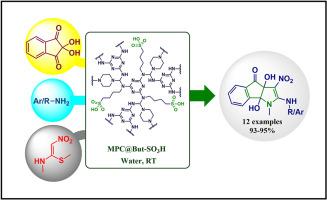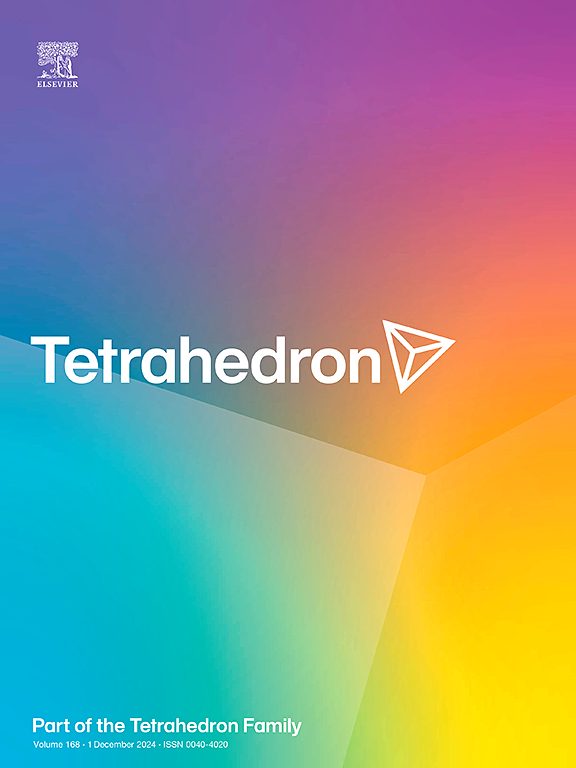MPC@But-SO3H a mesoporous heterogeneous organocatalyst in one-pot tandem synthesis of dihydroindeno[1,2-b]pyrrole derivatives
IF 2.2
3区 化学
Q2 CHEMISTRY, ORGANIC
引用次数: 0
Abstract
A sustainable, metal-free, and highly efficient protocol for the synthesis of dihydroindeno[1,2-b]pyrrole derivatives via a tandem one-pot three-component reaction in aqueous medium at room temperature using an effective and reusable mesoporous heterogeneous organocatalyst, MPC@But-SO3H has been developed. MPC@But-SO3H was easily synthesized using a melamine-based covalent organic polymer and 1,4-butane sultone. The organocatalyst was well characterized by numerous spectroscopic techniques such as Fourier Transform Infrared (FTIR), Brunauer-Emmett-Teller (BET), X-ray photoelectron spectroscopy (XPS), Powder X-ray diffraction (PXRD), Scanning Electron Microscope (SEM), Energy Dispersive X-ray (EDX), elemental mapping, and Thermal Gravimetric (TG) analyses. The catalyst displayed excellent catalytic potential, high thermochemical stability, and reusability for up to eight catalytic cycles. It offered the title compounds in excellent yields (˃90%) in a short reaction time (9-14 min). The synthesized compounds were characterized through FTIR, 1H, and 13C Nuclear Magnetic Resonance (NMR), and the molecular structure of 2-(benzylamino)-3a,8b-dihydroxy-1-methyl-3-nitro-3a,8b-dihydroindeno[1,2-b]pyrrol-4(1H)-one (4a) was confirmed by the Single Crystal XRD (SC-XRD) analysis. The key features of the present protocol include the use of water as a green solvent, zero involvement of any metal, sustainable reaction conditions, easy catalyst recovery, and a simple work-up procedure. The calculations for green metrics parameters further supported the greenness and sustainability of the protocol.

介孔异质有机催化剂 MPC@But-SO3H 在二氢茚并[1,2-b]吡咯衍生物的一锅串联合成中的应用
本研究开发了一种可持续、无金属、高效的方法,利用一种有效且可重复使用的介孔异质有机催化剂 MPC@But-SO3H,在室温水介质中通过串联单锅三组分反应合成二氢茚并[1,2-b]吡咯衍生物。MPC@But-SO3H 使用三聚氰胺基共价有机聚合物和 1,4-丁烷内酯轻松合成。傅立叶变换红外光谱 (FTIR)、Brunauer-Emmett-Teller (BET)、X 射线光电子能谱 (XPS)、粉末 X 射线衍射 (PXRD)、扫描电子显微镜 (SEM)、能量色散 X 射线 (EDX)、元素图谱和热重力分析 (TG) 等多种光谱技术对该有机催化剂进行了表征。该催化剂具有出色的催化潜力、较高的热化学稳定性和可重复使用长达八个催化循环的能力。它能在较短的反应时间(9-14 分钟)内以极高的产率(˃90%)合成标题化合物。合成的化合物通过傅立叶变换红外光谱(FTIR)、1H 和 13C 核磁共振(NMR)进行了表征,2-(苄基氨基)-3a,8b-二羟基-1-甲基-3-硝基-3a,8b-二氢茚并[1,2-b]吡咯-4(1H)-酮(4a)的分子结构通过单晶 XRD(SC-XRD)分析得到了证实。本方案的主要特点包括使用水作为绿色溶剂、不涉及任何金属、反应条件可持续、催化剂易于回收以及工作程序简单。对绿色指标参数的计算进一步证明了该方案的绿色性和可持续性。
本文章由计算机程序翻译,如有差异,请以英文原文为准。
求助全文
约1分钟内获得全文
求助全文
来源期刊

Tetrahedron
化学-有机化学
CiteScore
3.90
自引率
4.80%
发文量
439
审稿时长
34 days
期刊介绍:
Tetrahedron publishes full accounts of research having outstanding significance in the broad field of organic chemistry and its related disciplines, such as organic materials and bio-organic chemistry.
Regular papers in Tetrahedron are expected to represent detailed accounts of an original study having substantially greater scope and details than that found in a communication, as published in Tetrahedron Letters.
Tetrahedron also publishes thematic collections of papers as special issues and ''Reports'', commissioned in-depth reviews providing a comprehensive overview of a research area.
 求助内容:
求助内容: 应助结果提醒方式:
应助结果提醒方式:


